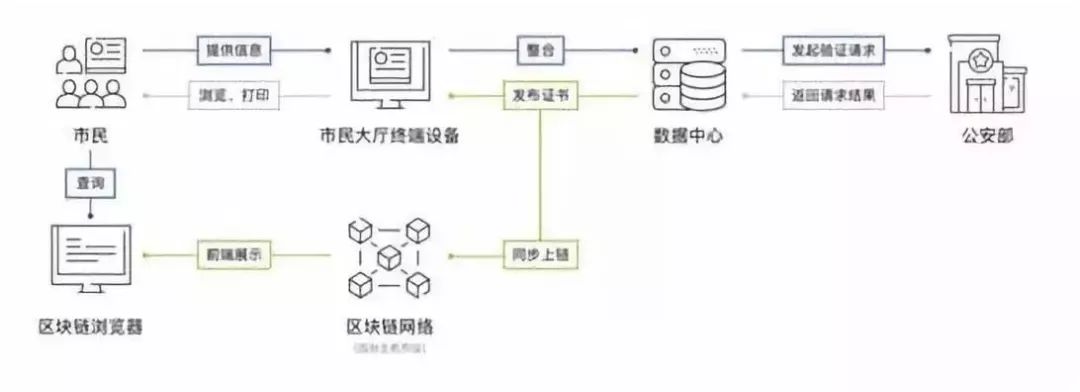Hangzhou launched “government service chain” “One main multi-side” technical structure to meet government needs
Author: R-Lin
Administrative blockchain +: "Maximum run once" trusted authentication scenario
"When we selected the business scene in the early stage, we chose the scene that is most conducive to the 'national economy and people's livelihood'. The 'run at most once' is very suitable, especially in terms of data sharing and credibility, the blockchain can play a big role. Therefore, the scene of 'trusted identity authentication' in the citizen's service was chosen." Technology provider Babbit's vice president and BYSTACK CEO Ma Qianli told Firebird Finance.

- Why is the project of Stanford University becoming more and more in China?
- Behind the "per-billion dollar bitcoin permanent loss": Bitcoin almost died
- Viewpoint | Checking the block Nonce distribution to track changes in mining equipment
The "trusted identity authentication" was first proposed based on the development of the Internet. On the one hand, there is a need for network real-name authentication, and on the other hand, there is a risk of personal information leakage. In the specific operation process, the ID card number and other personal information are separated from the physical carrier of the ID card, which is only a string of characters. The inquiry system can only solve the information in the population system, but it cannot solve the real name. It’s a real problem.
The “trusted identity authentication” of the government service chain is when the citizens handle multi-sectoral business, after submitting personal information to the data center of the data resource management bureau, they initiate verification requests to the Ministry of Public Security to obtain verification results, and return to the data center to issue certificates to enter the blockchain system. In the cross-department use, the identity information is verified and verified, so that there is a blockchain entry and exit call. It is proved by the time-stamped information that once the chain is on, the citizens can read the data from the higher authorities without going back and forth, which greatly improves the longer validity period and wider application scope of the citizen's identity information. In the future, as more departments become chain nodes, cross-departmental, cross-city, and inter-provincial collaborative government offices will be more convenient.

The “government service chain” is affectionately called “Hangzhou Chain” by people in the industry. Talking about the future development direction, Ma Qianli said: "The trusted identity authentication and storage service is only the first proof of concept application of the government blockchain application, the purpose is to test the stability and availability of the blockchain system. The next direction is More scenes are included, and blockchain scenes are connected in series, which will result in '1+1 greater than 2'. For example, the citizen's identity authentication data is linked, and the citizen's garbage classification and recovery points data is linked. The citizen's environmental protection and energy-saving data is on the chain, so the government can take the initiative to provide services to those with good data, which is also the embodiment of deepening the most-running reform."
“One main multi-side” technical architecture meets government needs
The “government service chain” adopts the “one main multi-side” technical structure, and initially lays up four blockchain nodes. It started trial operation in May this year, and totaled more than 3 million in six months, and actually supported Letter application scenario. Talking about the operation of the "government service chain", Ma Qianli introduced: "There are already so many blocks, but only on behalf of the smooth operation of so many blocks, in the future we will also provide technical support and escort for the operation of this chain. Next we will continue to enrich the application scenario and increase the number of nodes."

The architecture of “one main multi-side” technology is essentially a cross-chain solution, with a layered structure that breaks down the three characteristics of “decentralization, security, and efficiency”. Specifically, the "main" in "one main multi-side" is the chain of the data resource authority, and the "multi-side" is the specific side chain of the scene in each application scenario. The main chain maintains stability and security, and the side chains are specifically optimized according to the scene (such as high-frequency scene matching high TPS side chains).
In the future, the “government service chain” will develop in two directions: First, expand more applications (DAPP) at the upper level and build a more prosperous ecosystem. Second, expand more nodes. On the basis of the Hangzhou Data Resources Administration, more local government departments will be introduced to make the underlying chain more robust.
We will continue to update Blocking; if you have any questions or suggestions, please contact us!
Was this article helpful?
93 out of 132 found this helpful
Related articles
- The patron saint of DeFi: talk about the new "insurance" track
- Introduction to Blockchain | Valuation Models for Blockchain Industry and Its Disadvantages
- QKL123 Quote Analysis | What is Bitcoin? Can be compared to gold (1121)
- After upgrading the multi-mortgage Dai, MakerDao will do these in the next 10 years.
- Nasdaq ringing the bell soon, taking you back to Jianan Zhizhi, a three-year IPO road.
- SheKnows 丨嘉楠耘智 will become the "first block of the blockchain", can blockchain companies usher in the tide of listing?
- Regulatory policy is not clear, one of South Africa’s “five major banks” announced the closure of the bank account of the cryptocurrency exchange






